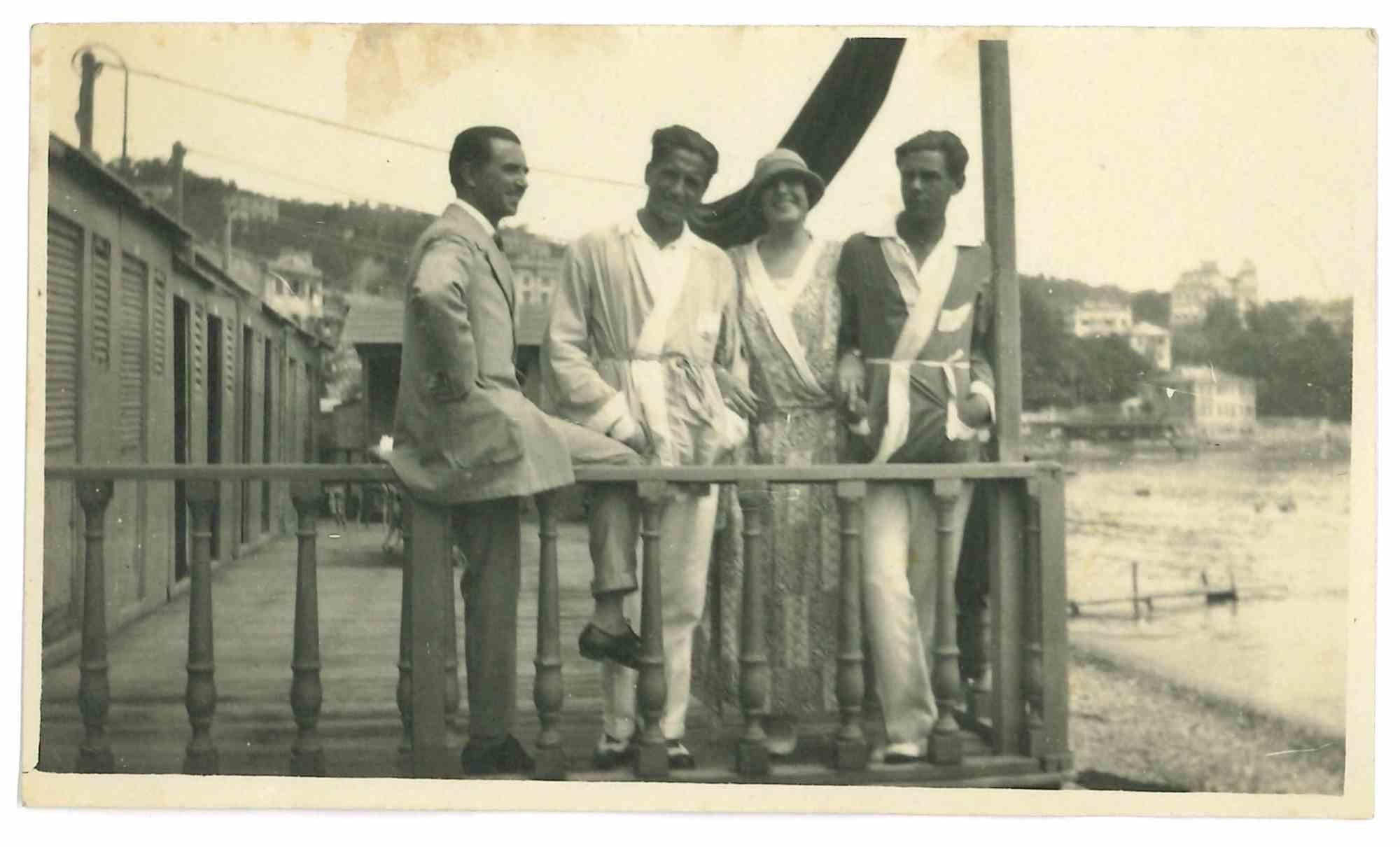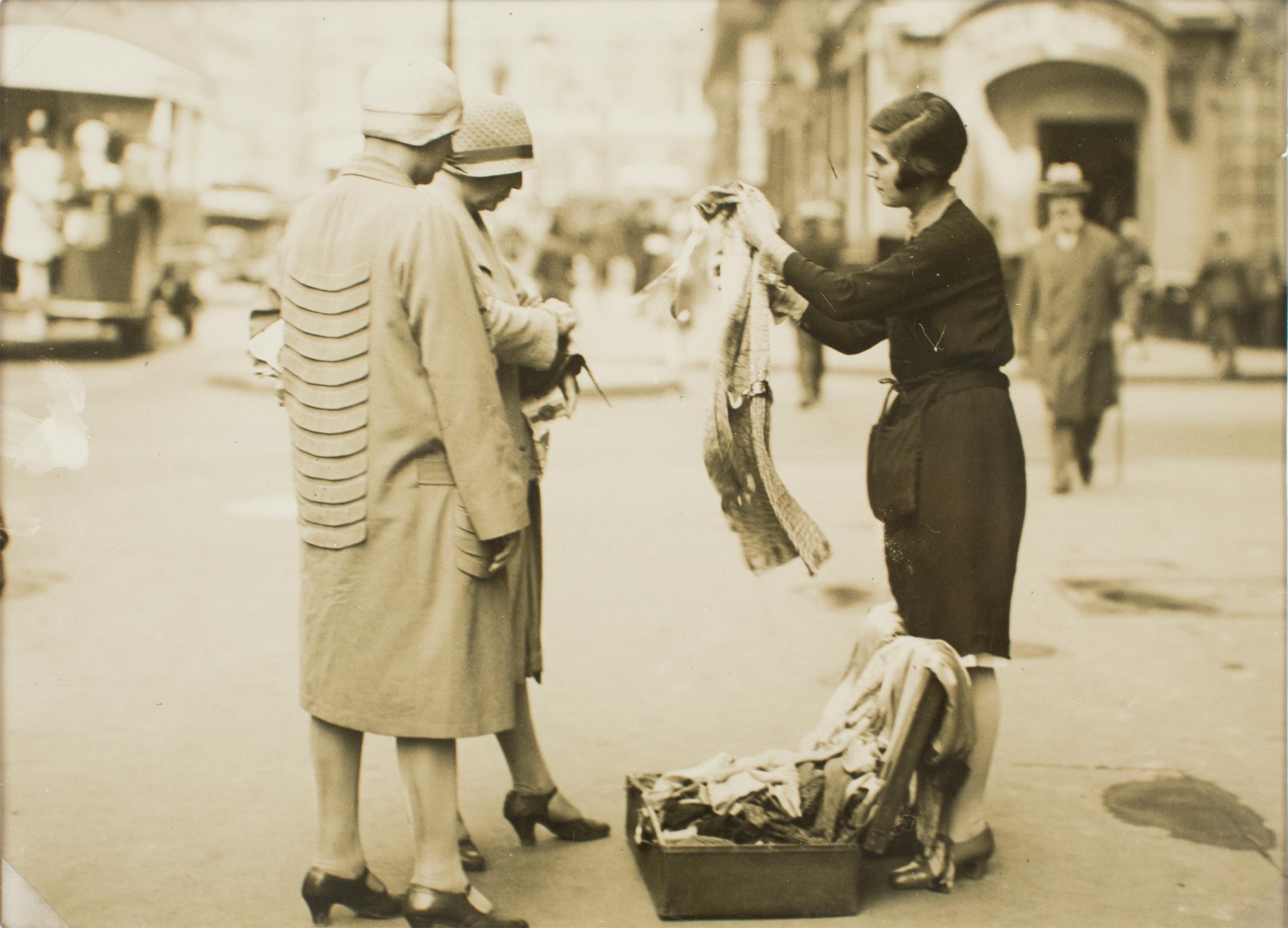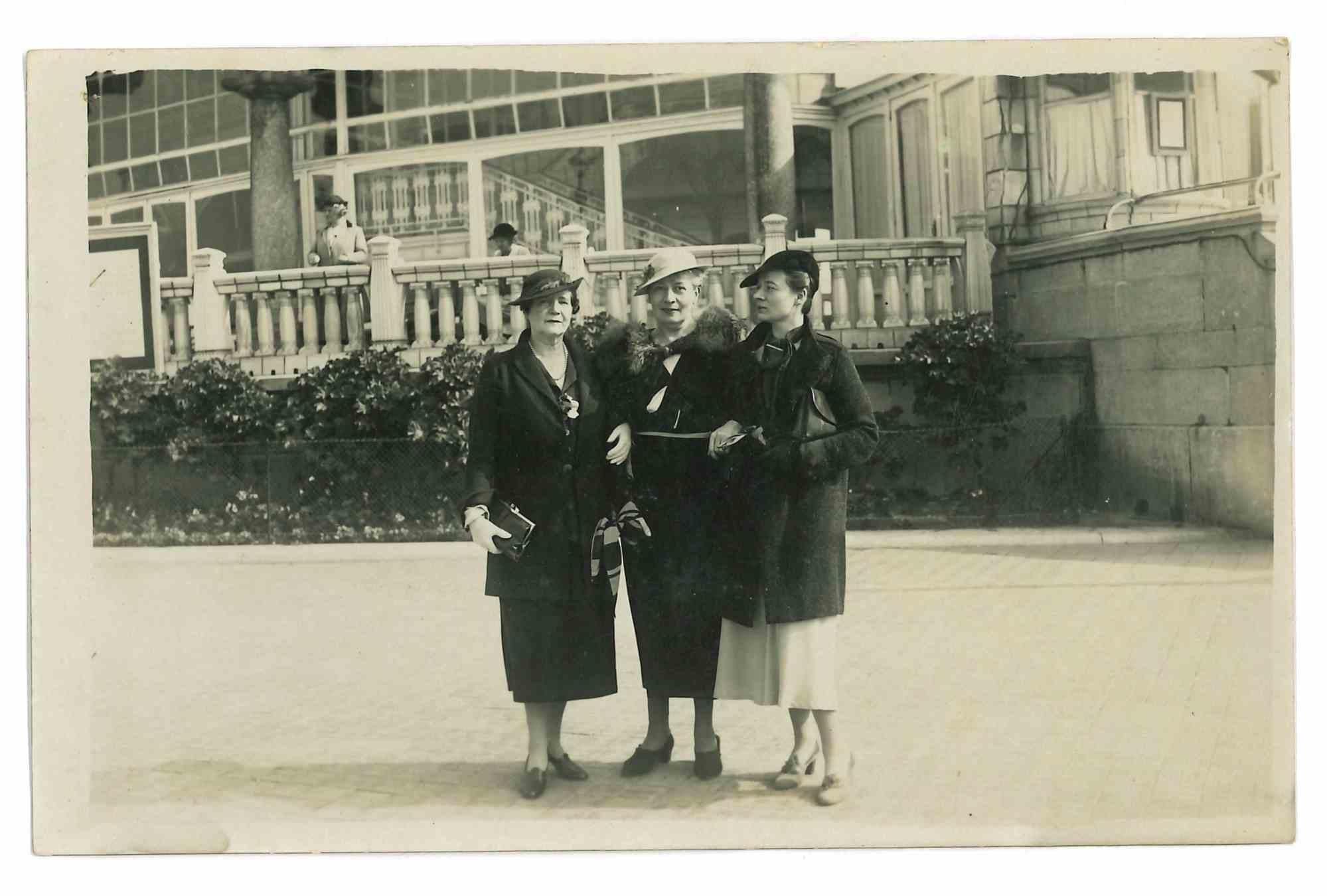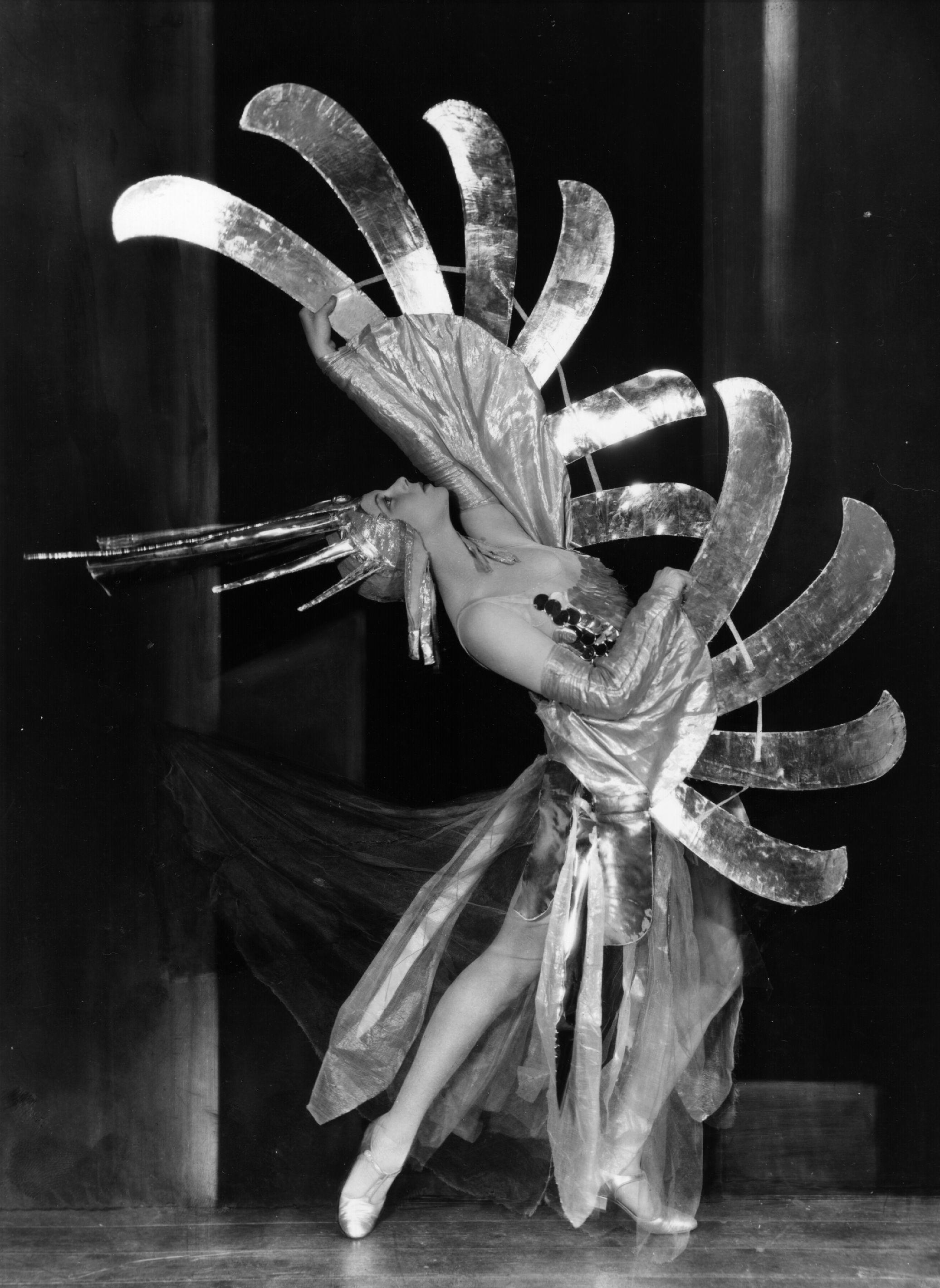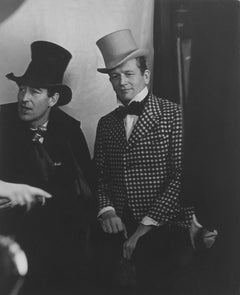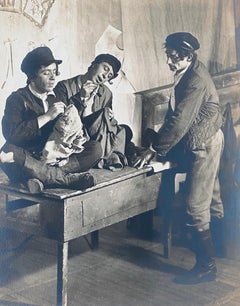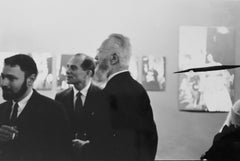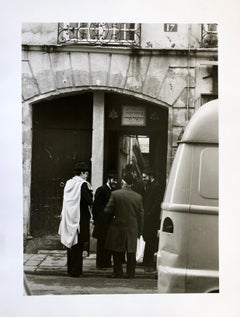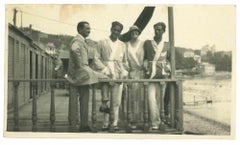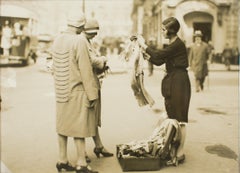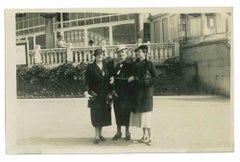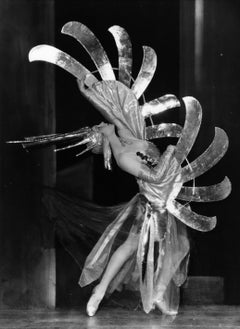Items Similar to German Jewish Weimar Era Silver Gelatin Photograph Pre War Judaica Costume Party
Want more images or videos?
Request additional images or videos from the seller
1 of 7
Arno Katz German Jewish Weimar Era Silver Gelatin Photograph Pre War Judaica Costume Party
$750
£572.62
€661.66
CA$1,052.86
A$1,173.52
CHF 615.71
MX$14,330.59
NOK 7,796.17
SEK 7,368.57
DKK 4,938.25
About the Item
Rare German Judaica. Arno Katz Foto for Atelier Bermann, Frankfurt, Germany.
bears original stamp verso
The Weimar Republic (German: Weimarer Republik [ˈvaɪmaʁɐ ʁepuˈbliːk] (About this soundlisten)), officially the German Reich (Deutsches Reich), also referred to as the German People's State (Deutscher Volksstaat) or simply the German Republic (Deutsche Republik), was the German state from 1918 to 1933. As a term, it is an unofficial historical designation that derives its name from the city of Weimar, where its constituent assembly first took place. The official name of the republic remained the German Reich as it had been during the German Empire because of the German tradition of substates.
Although commonly translated as "German Empire," Reich here better translates as "realm" in that the term does not necessarily have monarchical connotations in itself. The Reich was changed from a constitutional monarchy into a republic. In English, the country was usually known simply as Germany, and the Weimar Republic name became mainstream only in the 1930s.
Germany became a de facto republic on 9 November 1918 when Kaiser Wilhelm II abdicated the German and Prussian thrones with no agreement made on a succession by his son Crown Prince Wilhelm; and became a de jure republic in February 1919 when the position of President of Germany was created. A national assembly was convened in Weimar, where a new constitution for Germany was written and adopted on 11 August 1919. In its fourteen years, the Weimar Republic faced numerous problems, including hyperinflation, political extremism (with contending paramilitaries) as well as contentious relationships with the victors of the First World War. Resentment in Germany towards the Treaty of Versailles was strong especially on the political right where there was great anger towards those who had signed and submitted to the treaty. The Weimar Republic fulfilled most of the requirements of the Treaty of Versailles although it never completely met its disarmament requirements and eventually paid only a small portion of the war reparations (by twice restructuring its debt through the Dawes Plan and the Young Plan).[7] Under the Locarno Treaties, Germany accepted the western borders of the country by abandoning irredentist claims on France and Belgium, but continued to dispute the eastern borders and sought to persuade Austria to rejoin Germany, which it had been during the German Confederation of 1815 to 1866.
From 1930 onwards, President Paul von Hindenburg used emergency powers to back Chancellors Heinrich Brüning, Franz von Papen and General Kurt von Schleicher. The Great Depression, exacerbated by Brüning's policy of deflation, led to a surge in unemployment.[8] In 1933, Hindenburg appointed Adolf Hitler as Chancellor with the Nazi Party being part of a coalition government. The Nazis held two out of the remaining ten cabinet seats. Von Papen as Vice Chancellor was intended to be the "éminence grise" who would keep Hitler under control, using his close personal connection to Hindenburg. Within months, the Reichstag Fire Decree and the Enabling Act of 1933 had brought about a state of emergency as it wiped out constitutional governance and civil liberties. Hitler's seizure of power (Machtergreifung) was permissive of government signed by decree without legislative participation. These events brought the republic to an end—as democracy collapsed, the founding of a single-party state began the dictatorship of the Nazi era.
- Creator:Arno Katz
- Dimensions:Height: 3 in (7.62 cm)Width: 5.5 in (13.97 cm)
- Medium:
- Movement & Style:
- Period:
- Condition:Minor edge discolouration. Please see photos.
- Gallery Location:Surfside, FL
- Reference Number:1stDibs: LU38215437972
About the Seller
4.9
Platinum Seller
Premium sellers with a 4.7+ rating and 24-hour response times
Established in 1995
1stDibs seller since 2014
1,786 sales on 1stDibs
Typical response time: <1 hour
- ShippingRetrieving quote...Shipping from: Surfside, FL
- Return Policy
Authenticity Guarantee
In the unlikely event there’s an issue with an item’s authenticity, contact us within 1 year for a full refund. DetailsMoney-Back Guarantee
If your item is not as described, is damaged in transit, or does not arrive, contact us within 7 days for a full refund. Details24-Hour Cancellation
You have a 24-hour grace period in which to reconsider your purchase, with no questions asked.Vetted Professional Sellers
Our world-class sellers must adhere to strict standards for service and quality, maintaining the integrity of our listings.Price-Match Guarantee
If you find that a seller listed the same item for a lower price elsewhere, we’ll match it.Trusted Global Delivery
Our best-in-class carrier network provides specialized shipping options worldwide, including custom delivery.More From This Seller
View AllVintage Silver Gelatin Photograph Thomas Hoving John Lindsey Costume Party Photo
By Fred McDarrah
Located in Surfside, FL
Thomas Hoving and John Lindsay at a benefit party 1/18/1967
Photographer is Fred McDarrah
Over a 50-year span, McDarrah documented the rise of the Beat Generation, the city’s postmodern art movement, its off-off-Broadway actors, troubadours, politicians, agitators and social protests.
Fred captured Jack Kerouac frolicking with women at a New Year’s bash in 1958, Andy Warhol adjusting a movie-camera lens in his silver-covered factory, and Bob Dylan offering a salute of recognition outside Sheridan Square near the Voice’s old office.
Not just a social chronicler, McDarrah was a great photo-journalist.
For years, McDarrah was the Voice's only photographer and, for decades, he ran the Voice’s photo department, where he helped train dozens of young photographers, including James Hamilton, Sylvia Plachy, Robin Holland and Marc Asnin. His mailbox was simply marked "McPhoto."
An exhibit of McDarrah’s photos of artists presented by the Steven Kasher Gallery in Chelsea was hailed by The New York Times as “a visual encyclopedia of the era’s cultural scene.”
artists in their studios, (Alice Neel, Philip Guston, Stuart Davis, Robert Smithson, Jasper Johns, Franz Kline), actors (Dustin Hoffman, Robert De Niro on the set of “Taxi Driver”), musicians (Janis Joplin, Alice Cooper, Bob Dylan) and documentary images of early happenings and performances (Yayoi Kusama, Charlotte Moorman, Al Hansen, Jim Dine, Nam June Paik). The many images of Andy Warhol include the well-known one with his Brillo boxes at the Stable Gallery in 1964. Woody Allen, Diane Arbus, W. H. Auden, Francis Bacon, Joan Baez, Louise Bourgeois, David Bowie, Jimmy Breslin, William Burroughs, John Cage, Leo Castelli, Christo, Leonard Cohen, Merce Cunningham, William de Kooning, Jim Dine, Mark di Suvero, Marcel Duchamp, Bob Dylan, Federico Fellini, Allen Ginsberg, Robert Indiana, Mick Jagger, Jasper Johns, Kusama, John Lennon, Sol Lewitt, Roy Lichtenstein, Nam June Paik, Elvis Presley, Claes Oldenburg, Yoko Ono, Robert Rauschenberg, Lou Reed, James Rosenquist, Mark Rothko, Ed Ruscha, Robert Smithson, Susan Sontag, Andy Warhol, and others. McDarrah’s prints have been collected in depth by the J. Paul Getty Museum and the National Portrait Gallery, Washington. His work is in numerous public and private collections.
Thomas Pearsall Field Hoving was an American museum executive and consultant and the director of the Metropolitan Museum of Art. He was born in New York City to Walter Hoving, the head of Tiffany & Company, and his wife, Mary Osgood Field, a descendant of Samuel Osgood. Hoving grew up surrounded by New York's upper social strata. As recounted in his memoir, Making the Mummies Dance, these early experiences would be invaluable in his later dealings with the Met's donors and trustees.
He edited Connoisseur Magazine from 1981 to 1991; along with his memoirs of his time at the Met, he is also the author of books on a number of art-related subjects, including art forgeries, Grant Wood, Andrew Wyeth, Tutankhamun, and the 12th-century walrus ivory crucifix...
Category
1960s American Modern Black and White Photography
Materials
Silver Gelatin
Artef Yiddish Theater Photograph
Located in Surfside, FL
Alfredo Valente (1899-1973) was an Italian born American photographer known for his prolific career chronicling Broadway theatre. He is also credited as a singer, painter, art collector, dealer, and cultural administrator.
Valente was born in Calabria, Italy where he trained as a fine artist and opera singer. In 1927, he immigrated to the United States where he performed opera in public. However, his singing career did not take off and he pivoted to focus on his photography.
In 1931, he became the photographer for the newly formed Group Theater, an experimental theater company based in New York co-founded by Lee Strasberg. By the mid-1930s, Valente was regularly published by magazines and newspapers, most notably Stage, a magazine dedicated to Broadway theater. Valente was lauded as one of the leading theater photographers of the day and his use of artistic camera angles and dramatic lighting became his signature. He also became known for portraying actors and dancers in costume, but not while performing. In addition to Broadway, Valente photographed American Ballet Theatre (then known as Ballet Theatre) during the company's formative years during the 1940s. He photographed some of Ballet Theatre's most prominent dancers, such as Harold Lang...
Category
Mid-20th Century Black and White Photography
Materials
Photographic Paper
Vintage Silver Gelatin Signed Photograph Edward Steichen, MoMA Photo
By Fred McDarrah
Located in Surfside, FL
Edward Steichen, John Durniak, Monroe Wheeler and Edward D. Museum of modern art on Feb 10, 1962
Photographer Fred McDarrah
Over a 50-year span, McDarrah documented the rise of the Beat Generation, the city’s postmodern art movement, its off-off-Broadway actors, troubadours, politicians, agitators and social protests.
Fred captured Jack Kerouac frolicking with women at a New Year’s bash in 1958, Andy Warhol adjusting a movie-camera lens in his silver-covered factory, and Bob Dylan offering a salute of recognition outside Sheridan Square near the Voice’s old office.
Not just a social chronicler, McDarrah was a great photo-journalist.
For years, McDarrah was the Voice's only photographer and, for decades, he ran the Voice’s photo department, where he helped train dozens of young photographers, including James Hamilton, Sylvia Plachy, Robin Holland and Marc Asnin. His mailbox was simply marked "McPhoto."
An exhibit of McDarrah’s photos of artists presented by the Steven Kasher Gallery in Chelsea was hailed by The New York Times as “a visual encyclopedia of the era’s cultural scene.”
artists in their studios, (Alice Neel, Philip Guston, Stuart Davis, Robert Smithson, Jasper Johns, Franz Kline), actors (Dustin Hoffman, Robert De Niro on the set of “Taxi Driver”), musicians (Janis Joplin, Alice Cooper, Bob Dylan) and documentary images of early happenings and performances (Yayoi Kusama, Charlotte Moorman, Al Hansen, Jim Dine, Nam June Paik). The many images of Andy Warhol include the well-known one with his Brillo boxes at the Stable Gallery in 1964. Woody Allen, Diane Arbus, W. H. Auden, Francis Bacon, Joan Baez, Louise Bourgeois, David Bowie, Jimmy Breslin, William Burroughs, John Cage, Leo Castelli, Christo, Leonard Cohen, Merce Cunningham, William de Kooning, Jim Dine, Mark di Suvero, Marcel Duchamp, Bob Dylan, Federico Fellini, Allen Ginsberg, Robert Indiana, Mick Jagger, Jasper Johns, Kusama, John Lennon, Sol Lewitt, Roy Lichtenstein, Nam June Paik, Elvis Presley, Claes Oldenburg, Yoko Ono, Robert Rauschenberg, Lou Reed, James Rosenquist, Mark Rothko, Ed Ruscha, Robert Smithson, Susan Sontag, Andy Warhol, and others. McDarrah’s prints have been collected in depth by the J. Paul Getty Museum and the National Portrait Gallery, Washington. His work is in numerous public and private collections.
Edward Jean Steichen (March 27, 1879 – March 25, 1973) was a Luxembourgish American photographer, painter, and art gallery and museum curator. Steichen's were the photographs that most frequently appeared in Alfred Stieglitz's groundbreaking magazine Camera Work during its publication from 1903 to 1917. Together Stieglitz and Steichen opened the Little Galleries of the Photo-Secession, which eventually became known as '291', after its address.
Steichen laid claim to his photos of gowns for the magazine Art et Décoration in 1911 being the first modern fashion photographs ever published. From 1923 to 1938, Steichen was a photographer for the Condé Nast magazines Vogue and Vanity Fair while also working for many advertising agencies including J. Walter Thompson. During these years, Steichen was regarded as the best known and highest paid photographer in the world. In 1944, he directed the war documentary The Fighting Lady, which won the 1945 Academy Award for Best Documentary.
From 1947 to 1961, Steichen served as Director of the Department of Photography at New York's Museum of Modern Art. While at MoMA, he curated and assembled exhibits including The Family of Man, which was seen by nine million people. In 1904, Steichen began experimenting with color photography. He was one of the earliest in the United States to use the Autochrome Lumière process. In 1905, Stieglitz and Steichen created the Little Galleries of the Photo-Secession, which eventually became known as 291 after its address. It presented some of the first American exhibitions of Henri Matisse, Auguste Rodin, Paul Cézanne, Pablo Picasso, and Constantin Brâncuși.
He worked with Robert Frank even before his The Americans was published, exhibited the early work of Harry Callahan and Aaron Siskind, and purchased two Rauschenberg prints...
Category
1960s American Modern Black and White Photography
Materials
Silver Gelatin
Vintage Signed Silver Gelatin Photograph Chabad Shul Pletzl Paris Judaica Photo
Located in Surfside, FL
17 Rue des Rosiers Paris, France.
A small Shul in the old Jewish quarter of Paris (the Pletzel), known as the ‘Zibetzin’, located at 17 Rue De Rosiers, The Lubavitcher Rebbe was kno...
Category
1970s Modern Black and White Photography
Materials
Silver Gelatin
Photo Purim Pestalozzi Str Synagogue Berlin Vintage Silver Gelatin Photograph
By Edward Serotta
Located in Surfside, FL
Edward Serotta
Purim in the Pestalozzi Strasse Synagogue Berlin.
silver gelatin print, matted, captioned by hand and hand signed and numbered. B/W photographs documenting Jewish li...
Category
1990s Realist Black and White Photography
Materials
Silver Gelatin
Vintage Silver Gelatin Photograph Surrealist Doll Art Photo, Jazz Photographer
Located in Surfside, FL
These were from a show of her work. Influenced by Surrealism and Dada Photographs
these are images of old children's dolls in various states of decay. These bear the influence of Ha...
Category
20th Century Surrealist Black and White Photography
Materials
Silver Gelatin
You May Also Like
The Old Days - Historical Photo - Early 20th Century
Located in Roma, IT
The Old Days - Historical Photo is a black and white vintage photo, realized in the early 20th century.
It belongs to historical album including historical moment, royal families,...
Category
Early 20th Century Modern Figurative Photography
Materials
Photographic Paper
Paris during the Great Depression circa 1930, Silver Gelatin B and W Photography
By Press Agency Keystone View Co.
Located in Atlanta, GA
A unique original silver gelatin black and white photograph by Press Agency Keystone View Co, Paris. Paris during the Great Depression, circa 1930...
Category
1930s Art Deco Black and White Photography
Materials
Silver Gelatin
The Old Days - Historical Photo - The Early 20th century
Located in Roma, IT
The Old Days - Historical Photo is a black and white vintage photo, realized in Early 20th century.
It belongs to historical album including historical moment, royal families, and ...
Category
1910s Modern Figurative Photography
Materials
Photographic Paper
Lethal Losch (1929) - Silver Gelatin Fibre Print
Located in London, GB
Happy Marilyn (1956) - Silver Gelatin Fibre Print
(Photo by Sasha/Getty Images)
6th April 1929:
Tilly Losch (1904 - 1974) dancing in an extravagant cost...
Category
1920s Modern Portrait Photography
Materials
Black and White, Silver Gelatin
The Old Days Photo - Early 20th Century
Located in Roma, IT
The Old Days Photo is a black and white vintage photo, realized in the early 20th century.
It belongs to historical album including historical moment, royal families, and political...
Category
Early 20th Century Modern Figurative Photography
Materials
Photographic Paper
Gathering - Vintage Photo - Early 20th Century
Located in Roma, IT
Gathering is a vintage photo, realized in the Early 20th Century .
The artwork is a well-balanced composition.
Category
Early 20th Century Modern Figurative Photography
Materials
Photographic Paper

